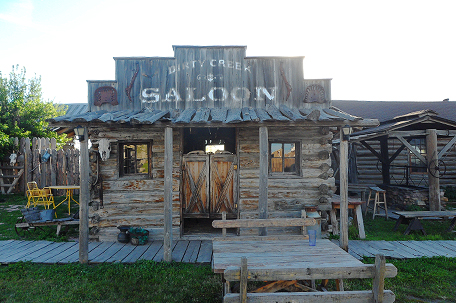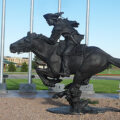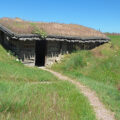
ABOVE PHOTO: Dirty Creek Saloon
By Renée S. Gordon
“It does not matter where his body lies for it is grass, but where his Spirit is.”
–Black Elk on Crazy Horse’s gravesite
Two events, the Westward Migration and the Homestead Act, had a major impact on Nebraska. The first groups of nonindigenous people in the region were hunters, traders and fur trappers who followed established Indian trails. In 1813, Robert Stuart and a group of Oregon trappers trekked their way into the Platte Valley and this journey is cited as the beginnings of the Oregon Trail. Milton Sublette, in 1830, is credited with being the first to lead a wagon train along the trail for fur trading purposes. Eleven years later the first wagon train of pioneers set out. It has been estimated that more than 350,000 emigrants crossed Nebraska via a historic trail in the 1800s on their way west. The 2,000-mile trip from Missouri to the coast took four months with the Nebraska portion lasting one month.
The Mormons fled religious persecution in 1846-47 in their first migration. Departing from Illinois their leader, Brigham Young, had the pioneer party follow the Platte River’s north bank to avoid contact with other emigrants who generally followed the south bank. Thousands of Mormons followed the trail to the Great Basin for the following decade. In 1855-56, some Mormons who could not afford wagons and oxen took to the trail with handcarts. Their use was so grueling that they soon became obsolete.
Three African Americans, Oscar Crosby, Green Flake and Hank Lay, are among the original 148 settlers listed on the “This is the Place” Monument. They made the initial journey with Young to Salt Lake. Flake made the trip a second time in 1848 after returning east to lead 91 Mormons to “Zion.” Ninety-one people followed him, 34 of which were black.
Eighteen treaties were signed from 1825 to 1892 between the federal government and the Native Americans of Nebraska. Each treaty wrested land, in what had been deemed Indian Territory, from native control. The 1854 Kansas-Nebraska Act sealed their fate when it opened the region to settlement by whites. Because of the slow pace at which the people were settling and because President Abraham Lincoln wanted to settle the land prior to the end of the Civil War, he urged the government to pass the Homestead Act of 1862 and to complete a transcontinental railroad. The railroad received huge land grants and the Homestead Act gifted 160 ares of land to anyone, including women, who lived on their acreage for five years. In 1861, Nebraska banned slavery and in 1867 it was admitted to the Union.
Alliance was founded in 1888 and was settled by homesteaders, many of whom had served in the Civil War. One of the settler’s biggest problems was a dearth of teachers. The town would lure them there with a job but even the least attractive women married almost immediately. They soon found it necessary to have them sign a contract that forbid them to wed for two years. www.cityofalliance.net
One of Alliance’s most unusual sites is the 10 acre Carhenge, Jim Reinders’ 1987 monument to his father. Reinders used 38 gray spray-painted vintage cars to reproduce England’s Stonehenge. The cars are either buried or welded together to a height of 15 to 16-ft and replicate the same dimensions as Stonehenge. Additional works are featured in the adjacent Car Art Reserve and gifts and services are available at the Pit Stop Shop. In June 2014, USA Today designated Carhenge one of the top three quirky landmarks in the country. Admission is free, it provides a great photo op and you absolutely must stop to explore. No surprise, Reinders expressed a desire to have his ashes placed in the car’s ashtrays upon his death. www.carhenge.com
Knight Museum and Sandhills Center interprets life in the region through five themes including a broad-ranging display of Native America artifacts, homestead and ranch memorabilia and railroad objects. The museum’s research center is an excellent repository of books, photographs, official records and genealogical information. www.knightmuseum.com
Crawford, Nebraska is located at the heart of many of Nebraska’s most unique sites and three miles from Fort Robinson. The village was founded in 1886 and the location was selected because the law said that towns could be no closer than three miles to a fort. It was named in honor of Lt. Emmet Crawford, a soldier from the fort who was killed in Mexico. This was the town where soldiers came for recreation and at one point Calamity Jane ran a tent show with a troop of dancing girls. www.crawfordnebraska.net
The largest dune field in the Western Hemisphere and largest “grass stabilized” dune field in the world is a 20,000-sq. mile area known as the Sandhills of Nebraska. Formed about 8,000-years ago, the Sandhills are made up of granulated quartz sand dunes as high as 400-ft. held in place by grass. Native Americans once hunted bison there but today it is home to more than 500,000 cattle. In 1984, the dunes were designated a National Natural Landmark. www.thenebraskasandhills.com
For more than 70-years Fort Robinson was the most significant military post in the area. It was established in 1874 as Camp Robinson. Its charge was to protect and supply the Red Cloud Indian Agency and protect the nearby Sidney-Deadwood Trail. The agency was relocated in 1877 and a year later the camp became Fort Robinson. It was named in honor of Lt. Levi Robinson who, while gathering wood in 1874, was killed by Red Cloud Agency Indians. www.stateparks.com/fort_robinson
The fort figures prominently in African American history because it was the base for the 9th and 10th cavalry regiments at various times. In 1885 the fort became regimental headquarters for the 9th. Their two most noted missions were being sent to quell the Pine Ridge Reservation Ghost Dance uprising in 1890 and their famous 104-mile, 24-hour, cavalry ride in December of 1890. After the grueling ride the 9th arrived the day after the battle. They found the 7th Cavalry, previously Custer’s unit, pinned down by Oglala Sioux warriors in a White Clay Creek canyon. They attacked from two sides and saved the 7th. In 1898 the 9th left Fort Robinson for the Spanish American War where they would see service in Cuba.
The 10th Cavalry arrived in Robinson in 1902 after fighting in the Battle of San Juan Hill. While it served as their regimental headquarters in 1906, they participated in the capture of Utes who left their Utah reservation. This would be the final northern plains military action against regional tribes. The 10th left the fort for the Philippines in 1907.
During the tenure of the black cavalries the 2nd and 3rd African American graduates of West Point and the first black chaplain, Henry Plummer, served there. Twenty-three black soldiers were awarded the Congressional Medal of Honor for conspicuous valor during the Indian Wars, 10 of these men served at Fort Robinson.
The impact of the black regiments at Fort Robinson on African American history cannot be overstated. Their presence enticed other blacks to move to the Great Plains. Many retired soldiers went on to become cowboys, as did other African Americans, eventually constituting an estimated third of the entire cowboy population.
Fort Robinson State Park is an outstanding destination whether you are seeking outdoor activities, immersive history experiences or a base from which to explore regional sites and attractions. The fort was decommissioned in 1946 but the complex includes 62 original and reconstructed buildings. Overnight accommodations are offered in the lodge and historic officer’s quarters and 100 camping sites are available as well as a full service restaurant. www.outdoornebraska.org
This is Nebraska’s largest state park and visitors should begin with an orientation tour by horse-drawn wagon, on horseback or in an open-air jeep. While on the tour special note should be taken of the early wooden buildings with native rock foundations and the brick buildings constructed after 1909.
Ta-sunko-witko, known to nonindigenous people as Crazy Horse, was born about 1843 to Lakota parents. During his youth he witnessed many scenes of military excess against his people and while a teenager he joined his first war party and developed a reputation for bravery. He was present at the Little Big Horn.
Nomadic bands of Indians had been ordered to return to their reservations in January of 1876. When this did not occur they were relentlessly pursued by the military. Word was sent to Crazy Horse that if he surrendered his people would be given their own reservation and on May 6, 1877 he surrendered to General Crook at the Red Cloud Agency. In September he left the reservation to place his ailing wife in the care of his parents and Crook ordered him arrested believing he might return to warfare.
On September 5, 1877, as Crazy Horse was being escorted to the guardhouse he was stabbed. Accounts vary as to who struck the fatal blow. He was carried to the Adjutant’s Office where, in spite of medical attention, he died. His father was present and it is documented that his last words were “Wash-tå,” meaning, “it is good.” Crazy Horse clung to the old ways and no photographic image or signature of his exists. His parents buried his body, as he requested, secretly in the hills and his gravesite remains unknown. Exacting reconstructions of the guardhouse and office are on the grounds of Fort Robinson in their original locations. Interpretive markers are located outside of the buildings and a marker indicates the spot where he was wounded.
Adjacent to these two buildings is the Cheyenne Outbreak Barracks where 149 Cheyenne were imprisoned and broke out in January of 1879. The building was converted into a barracks for enlisted men and their families in 1890. In 1898 the barracks, then occupied by Buffalo Soldiers, caught fire killing the two children of Sgt. Harvey Wallace of the 9th Cavalry.
Fort Robinson Museum is housed in the 1905 Post Headquarters. A 10-minute film, “The Many Lives of Fort Robinson,” provides a good overview and featured artifacts interpret the fort’s entire history. An outstanding series of displays is presented in a historic, fully outfitted, barracks. The story of the Buffalo Soldiers at the fort is fully related here through photographs, artifacts and documents. www.nebraskahistory.org/sites/fortrob
The region’s geologic story is recounted in the Trailside Museum of Natural History. Their most impressive exhibit is “Clash of the Mammoths.” More than 10,000-years ago, in the course of combat, the tusks of two bull mammoths became inextricably locked together and they died near Crawford. Their skeletal remains were discovered in 1962 and were put on display in 2006. www.trailside.unl.edu
There is something about Nebraska’s history and scenic beauty that moves its residents to preserve and protect it. One more of the really special aspects of Western Nebraska is that there are opportunities for visitors to experience unique accommodations surrounded by magnificent vistas and authentic artifacts and antiques.
High Plains Homestead is located on Pine Ridge within close proximity to the Badlands. This creative complex features a series of relocated and restored buildings that are furnished as they would have been in an 1800’s settlement. The structures include a post office, Deep Creek School, Badland’s Mercantile and Dirty Creek Saloon complete with swinging doors.
The six lodging options, the caballero, cowboy, hunter, homesteader, saloon girl and warrior are representative of individuals that would have been commonly visible in the Old West. The Drifter Cookshack serves three meals a day to registered guests and the occasional stranger passing through who has heard of their reputation for great food and homemade baked goods.
Your hosts, Mike and Linda Kesselring, will assist in arranging fossil hunting, birding, fishing, hunting and stargazing activities. A tip, Mike is a wealth of information on the culture of Old Western Nebraska and he is happy to share. www.highplainshomestead.com
Barn Anew is a luxury B&B in the shadow of rugged buttes and historic trails. The property was originally the homestead of a Pennsylvania widow with three children who arrived with no money and found the land devoid of trees and moisture. The original home was a four room wood frame that was eventually expanded to 17 rooms. Accommodations are decorated with 1880-90 bedroom sets and modern amenities. Guests have the option of sleeping inside or opting for a sheepherder’s wagon just outside.
Hosts Allan and Cher Maybee taught on the Wind River Indian Reservation in Wyoming and throughout those years they collected the Native American art that is displayed throughout the Barn. This is a rare opportunity to closely examine the intricacy of the beadwork, the textiles and the sheer beauty of the colors used to convey emotions and spirituality. Colonel Maybee is extremely well versed in Native American and Western culture and he will share with you his knowledge and expertise. The Barn is available for weddings, family reunions and other private events. It is a 2014 winner of Tripadvisor’s Certificate of Excellence. Reservations are highly recommended. www.barnanew.com
Rediscover the passion of those who made Nebraska great. Immerse yourself in Nebraska!
I wish you smooth travels!

















Leave a Comment